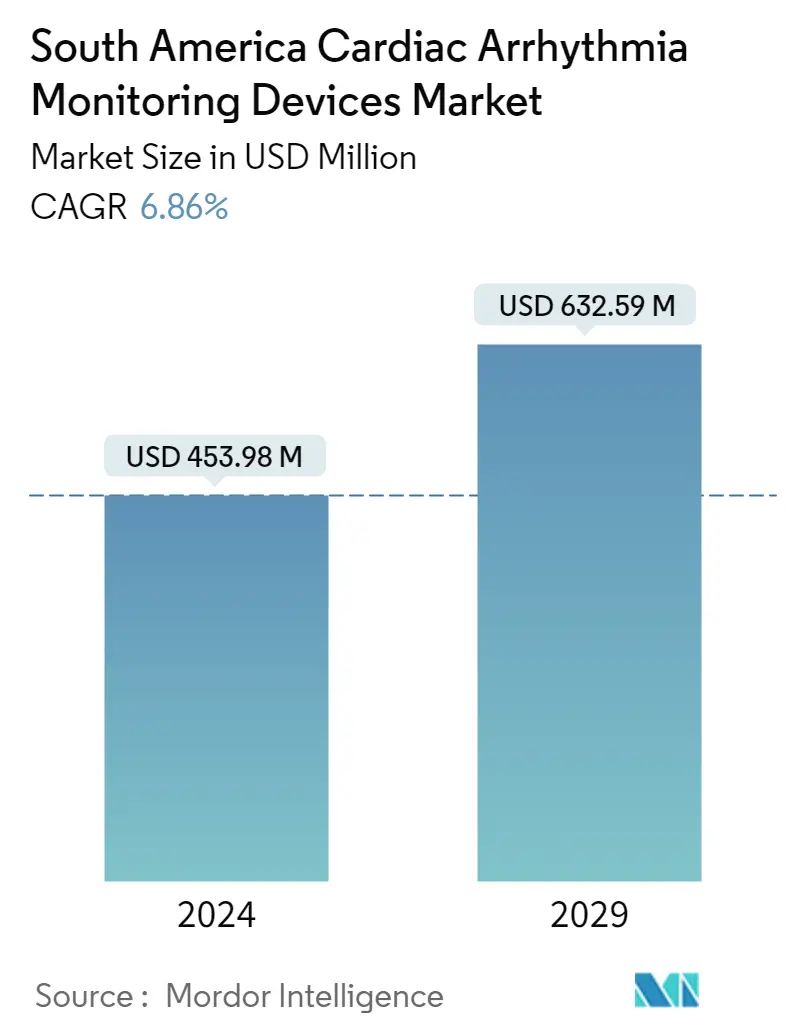Market Size of South America Cardiac Arrhythmia Monitoring Devices Industry

| Study Period | 2021 - 2029 |
| Base Year For Estimation | 2023 |
| Market Size (2024) | USD 453.98 Million |
| Market Size (2029) | USD 632.59 Million |
| CAGR (2024 - 2029) | 6.86 % |
| Market Concentration | Medium |
Major Players
*Disclaimer: Major Players sorted in no particular order |
South America Cardiac Arrhythmia Monitoring Devices Market Analysis
The South America Cardiac Arrhythmia Monitoring Devices Market size is estimated at USD 453.98 million in 2024, and is expected to reach USD 632.59 million by 2029, growing at a CAGR of 6.86% during the forecast period (2024-2029).
COVID-19 created difficulties for physicians whose cardiac patients are at risk and hesitant to come in for an appointment. The emergence of the COVID-19 pandemic initially had a negative impact on the cardiac arrhythmia monitoring business. Many medical treatments were suspended and used only in critical and emergency situations to reduce the danger of COVID-19 infection. The global lockdown had impacted the supply chain of pharmaceuticals, medical equipment, and biotechnology products. Furthermore, as a result of the developing cardiac problems linked with COVID-19, the market for arrhythmia monitoring devices was expected to rise in the future. According to the study published by World Health Organization in July 2021, COVID-19 individuals with cardiac disease were at a higher risk of complications or death, with a higher incidence of myocardial damage, shock, and arrhythmias. In COVID-19 individuals, the incidence of cardiovascular problems was 10% with supraventricular arrhythmia and 7.3% with ventricular arrhythmia. Atrial fibrillation was the most common arrhythmic complication in COVID-19 patients. Thus, the studied market was significantly impacted by the COVID-19 pandemic. However, the business has recovered well since the limitations were relaxed. The market recovery over the previous two years has been led by the increasing prevalence of heart illnesses new product introductions.
The market is driven by the increase use of telecardiology and the ease of use and portability of cardiac arrhythmia monitoring devices. According to the study published in SciELO Brazil in August 2021, cardiovascular diseases (CVDs) account for almost one-third of all fatalities in Brazil, as populations live longer, chronic diseases such as CVDs become more common. Telecardiology bridged the gap between the patient and the specialist professional, resulting in high patient and health professional satisfaction. As a result, the Pontifical Catholic University of Rio Grande do Sul (PUCRS) and the Institute of Cardiology of Rio Grande do Sul (ICFUC-RS) in Porto Alegre have launched a telecardiology program and a specific second opinion service to detect vulnerable CVD and improve local health care in 2020. Such initiatives are expected to boost market growth.
Cardiovascular diseases are the major cause of death in South America, which has increased the need for the development of cardiac monitoring devices in the region. According to a research study published in Diabetes nad Metabolic Syndrome in January 2022, In the Brazil sample, the prevalence of CVD and atherosclerotic CVD was 43.9% and 37.6%, respectively. Other factors, such as ease of use and portability of cardiac arrhythmia monitoring devices and the development of smart cardiac monitors are driving the South American cardiac arrhythmia monitoring devices market. However, the high cost of cardiac monitoring devices may restrain the market growth over the forecast period.
South America Cardiac Arrhythmia Monitoring Devices Industry Segmentation
As per the scope of the report, cardiac arrhythmia monitoring devices are used for monitoring patients at risk or with heart arrhythmia. These devices detect and alarm the heartbeats that are irregular being either too slow or too fast. The South America Cardiac Arrhythmia Monitoring Devices Market is segmented by Devices (Event Monitoring Devices, Continuous Rhythm Monitoring Devices, Holter Monitoring Devices, Other Devices), Service Providers (Mobile Cardiac Telemetry Monitoring Service Providers, Independent Diagnostic Testing Facilities/Clinics), and Geography (Brazil, Argentina, and Rest of South America). The report offers the value (in USD million) for the above segments.
| By Devices | |
| Event Monitoring Devices | |
| Continuous Rhythm Monitoring Devices | |
| Holter Monitoring Devices | |
| Other Devices |
| By Service Providers | |
| Mobile Cardiac Telemetry Monitoring Service Providers | |
| Independent Diagnostic Testing Facilities/Clinics |
| Geography | |||||
|
South America Cardiac Arrhythmia Monitoring Devices Market Size Summary
The South America cardiac arrhythmia monitoring devices market is poised for significant growth, driven by the increasing prevalence of cardiovascular diseases and the rising demand for advanced monitoring solutions. The market has shown resilience in the aftermath of the COVID-19 pandemic, which initially disrupted operations and supply chains but ultimately highlighted the need for effective cardiac monitoring due to the heightened risk of cardiovascular complications in infected patients. The adoption of telecardiology has further facilitated market expansion, bridging gaps between patients and healthcare professionals, and enhancing patient satisfaction. Initiatives like the telecardiology program by Pontifical Catholic University of Rio Grande do Sul and the Institute of Cardiology of Rio Grande do Sul are expected to contribute to market growth by improving healthcare access and outcomes.
The market is characterized by the dominance of Holter monitoring devices, which offer prolonged and convenient monitoring, thereby improving patient compliance and treatment outcomes. The geriatric population, being more susceptible to cardiovascular conditions, is a significant driver of demand for these devices. Brazil, with its universal healthcare system and a large aging population, is a key market contributor, benefiting from the country's private health sector trends and government initiatives like the Family Health Strategy. The presence of major global players such as Abbott Laboratories, GE Healthcare, and Medtronic PLC, along with strategic acquisitions, underscores the competitive landscape of the market. These factors collectively are expected to propel the growth of the cardiac arrhythmia monitoring devices market in South America over the forecast period.
South America Cardiac Arrhythmia Monitoring Devices Market Size - Table of Contents
-
1. MARKET DYNAMICS
-
1.1 Market Overview
-
1.2 Market Drivers
-
1.2.1 Increasing Use of Telecardiology
-
1.2.2 Ease of Use and Portability of Cardiac Arrhythmia Monitoring Devices
-
-
1.3 Market Restraints
-
1.3.1 High Cost of Cardiac Monitoring Devices
-
-
1.4 Porter's Five Force Analysis
-
1.4.1 Threat of New Entrants
-
1.4.2 Bargaining Power of Buyers/Consumers
-
1.4.3 Bargaining Power of Suppliers
-
1.4.4 Threat of Substitute Products
-
1.4.5 Intensity of Competitive Rivalry
-
-
-
2. MARKET SEGMENTATION (Market Size by Value - USD million)
-
2.1 By Devices
-
2.1.1 Event Monitoring Devices
-
2.1.2 Continuous Rhythm Monitoring Devices
-
2.1.3 Holter Monitoring Devices
-
2.1.4 Other Devices
-
-
2.2 By Service Providers
-
2.2.1 Mobile Cardiac Telemetry Monitoring Service Providers
-
2.2.2 Independent Diagnostic Testing Facilities/Clinics
-
-
2.3 Geography
-
2.3.1 South America
-
2.3.1.1 Brazil
-
2.3.1.2 Argentina
-
2.3.1.3 Rest of South America
-
-
-
South America Cardiac Arrhythmia Monitoring Devices Market Size FAQs
How big is the South America Cardiac Arrhythmia Monitoring Devices Market?
The South America Cardiac Arrhythmia Monitoring Devices Market size is expected to reach USD 453.98 million in 2024 and grow at a CAGR of 6.86% to reach USD 632.59 million by 2029.
What is the current South America Cardiac Arrhythmia Monitoring Devices Market size?
In 2024, the South America Cardiac Arrhythmia Monitoring Devices Market size is expected to reach USD 453.98 million.

